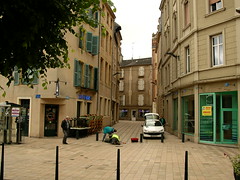Wednesday, June 08, 2005
In search of World War II: the Maginot Line
Scoff if you will, but World War II tourism can take you to some beautiful places. What difference does it make if your reason for driving the back roads through gorgeous European countryside is to find the perfect picnic spot or an old battlefield?
B and I ventured across the border to into the Alsace-Lorraine and established ourselves in the town of Thionville, just south of the France-Luxembourg border. One of the things I love about traveling in Europe is that, with the exception of a handful of ugly and colorless industrial cities, virtually any European town or small city is just so... so European. Though I doubt you’d find Thionville as a recommended stop in many guidebooks, it had charm and grace to augment its convenient location: about half an hour from the Maginot line and only an hour or so to Bastogne in Belgium.
The Maginot Line was the massive defense project undertaken by France in the 1920s and 1930s, a span of state-of-the-art fortifications running along the Franco-German border from the Alps northward to the Ardennes Forest on the edge of the French-Beligian border. The idea of the Maginot Line was to prevent a frontal invasion by Germany directly into France across this traditional historical invasion route; any German invasion would have to go through Belgium, which would give the French army time to mobilize and perhaps meet the German threat outside French soil.
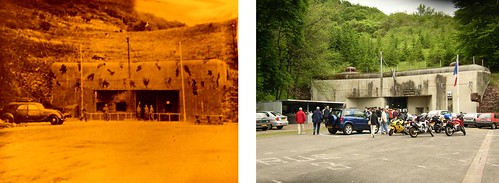
Left: German soldiers in front of entrance to Fort Hackenberg, Maginot Line in 1940.
Right: Tourists in front of Hackenberg entrance, 2005. Many of them are Germans.
Although the Maginot Line came to be seen as the very archetype of the wasteful white elephant defense program, more recent historians have begun to argue persuasively that in fact, the Maginot Line – which was never breached by any assault – fulfilled its purpose, and that the astonishingly rapid German conquest of France stemmed from the latter’s failures in the field, and in military intelligence, rather than from France’s allocation of vast resources into the Maginot Line. What you can see from a visit to the site that the Maginot Line fortresses were so well constructed that they are largely intact today; indeed, they are so sturdy that it is impracticable to dismantle them.
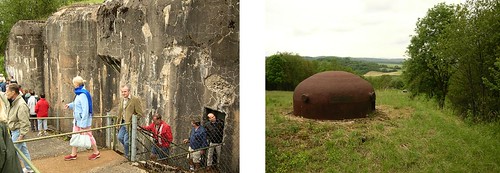
Left: surviving casemates swamped by tourists. Right: gun turrets sprouting
like mushrooms in the French countryside.
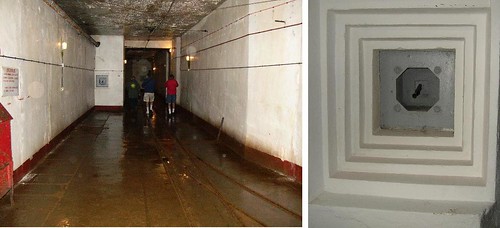
The entrance tunnel, typically wet with condensation. Note the welcoming
machine gun (small square at edge of photo to left, enlarged view, right).
We toured Hackenberg, one of several of the surviving Maginot Line forts that is open to the public as a museum. The three hour tour of the underground fortress network, which included a mile underground train ride between outposts, was fascinating... and leaves you with the impression that a three month tour of duty to the Maginot Line for French soldiers in 1939-1940 was at least as arduous and claustrophobic as submarine duty.
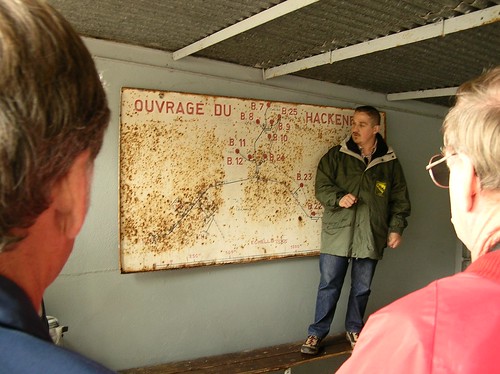
The French version of a tour "fuhrer."

The train we rode for a over a mile.
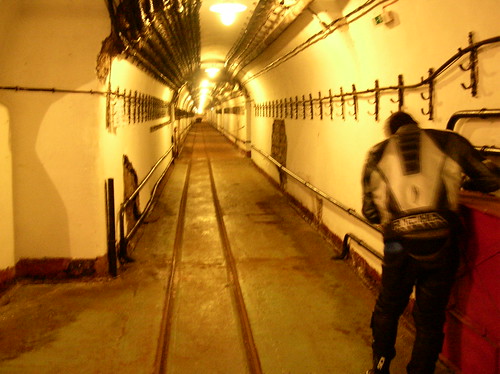
Typical Maginot Line tunnel. The train tracks are typical,
the British motorcycle dude in leather getup is probably not.
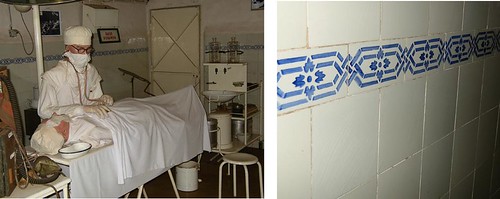
Not to get into that whole Mars-Venus thing -- B is knowledgable about and interested
in military history -- but she really did say: "Get a picture of that tile, will you?
I think it'd look good in our kitchen."
**
B and I ventured across the border to into the Alsace-Lorraine and established ourselves in the town of Thionville, just south of the France-Luxembourg border. One of the things I love about traveling in Europe is that, with the exception of a handful of ugly and colorless industrial cities, virtually any European town or small city is just so... so European. Though I doubt you’d find Thionville as a recommended stop in many guidebooks, it had charm and grace to augment its convenient location: about half an hour from the Maginot line and only an hour or so to Bastogne in Belgium.
Thionville shuts down at lunchtime in the traditional French way.
But for some reason, these guys were on the ground working.
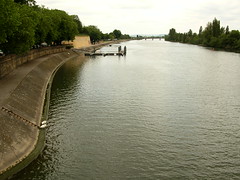
Thionville's waterfront on the Moselle River.
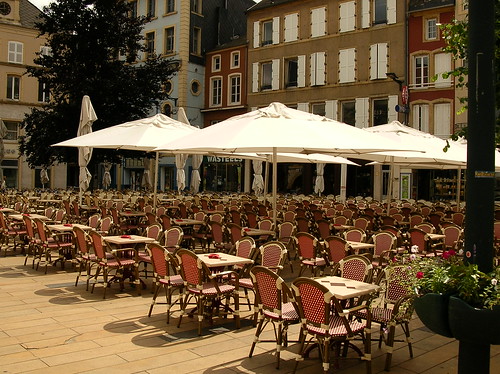
Chilly weather kept the outdoor cafe tables empty.
But for some reason, these guys were on the ground working.

Thionville's waterfront on the Moselle River.

Chilly weather kept the outdoor cafe tables empty.
The Maginot Line was the massive defense project undertaken by France in the 1920s and 1930s, a span of state-of-the-art fortifications running along the Franco-German border from the Alps northward to the Ardennes Forest on the edge of the French-Beligian border. The idea of the Maginot Line was to prevent a frontal invasion by Germany directly into France across this traditional historical invasion route; any German invasion would have to go through Belgium, which would give the French army time to mobilize and perhaps meet the German threat outside French soil.

Left: German soldiers in front of entrance to Fort Hackenberg, Maginot Line in 1940.
Right: Tourists in front of Hackenberg entrance, 2005. Many of them are Germans.
Although the Maginot Line came to be seen as the very archetype of the wasteful white elephant defense program, more recent historians have begun to argue persuasively that in fact, the Maginot Line – which was never breached by any assault – fulfilled its purpose, and that the astonishingly rapid German conquest of France stemmed from the latter’s failures in the field, and in military intelligence, rather than from France’s allocation of vast resources into the Maginot Line. What you can see from a visit to the site that the Maginot Line fortresses were so well constructed that they are largely intact today; indeed, they are so sturdy that it is impracticable to dismantle them.

Left: surviving casemates swamped by tourists. Right: gun turrets sprouting
like mushrooms in the French countryside.

The entrance tunnel, typically wet with condensation. Note the welcoming
machine gun (small square at edge of photo to left, enlarged view, right).
We toured Hackenberg, one of several of the surviving Maginot Line forts that is open to the public as a museum. The three hour tour of the underground fortress network, which included a mile underground train ride between outposts, was fascinating... and leaves you with the impression that a three month tour of duty to the Maginot Line for French soldiers in 1939-1940 was at least as arduous and claustrophobic as submarine duty.

The French version of a tour "fuhrer."

The train we rode for a over a mile.

Typical Maginot Line tunnel. The train tracks are typical,
the British motorcycle dude in leather getup is probably not.

Not to get into that whole Mars-Venus thing -- B is knowledgable about and interested
in military history -- but she really did say: "Get a picture of that tile, will you?
I think it'd look good in our kitchen."
**
Subscribe to Comments [Atom]
